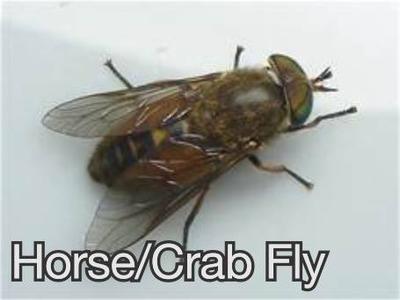Flying bugs and all that itches
by Tracey J - WHP Practitioner
( Espiritu del Viento - Casares)

Flying bugs and all that itches
Summer on the Costa del Sol is not all sunshine and sangria if you own a horse. It is the time when us equestrians take up arms in battle against mosquitos and flies to stop our horses itching. At best they will be swishing their tails and stomping their feet. At worst they will rub out their manes, tails and all the hair along their backs. From the human perspective the latter makes them impossible to ride as they suffer open sores, the former makes them still pretty difficult to ride as they fly-kick, toss their heads and snake their necks in an effort to rid themselves of the pests.
Far more important is the equine perspective. We have horse flies, also known as crab flies, due to the way they scuttle sideways across our horses haunches and all around their nether regions. These tend to bother their humans more than them. Most horses can happily ignore these little critters, but if you feel the need to rid your horse of them then you do have to squash, dismember and drown them to be sure they are dead! They don't give up without a fight. The easiest way is to hose the genital area of your horse, where they usually hang out, and as they rush out over the croup and rump you can pick them off and either drown them in a bucket of water or mash them well and truly into the ground. For those that can, sticking your nail into them, assuring they are completely broken in two, is a sure method to guarantee their death. Drowning doesn't always work as they can often make it to the side of the bucket and out long before meeting a watery tome.
Then we have Tabano flies. These are rather huge black things that are mostly bothersome in forest areas. They suck blood, but are easily swatted and squashed in the process as you ride along (when you can reach).
What appear to be newbies this past couple of years is a very small, regular looking fly (though hey, I haven't caught one and inspected it under a microscope!) that bites. I mean bites like mini electric shocks. It really is an evil little beast. Not at all discriminatory, it will also bite you, through your clothing. Apart from the biting, though that's more than enough, they don´t cause itching or leave welts or bumps.
The ones that really bother horses and can cause Samson's downfall, along with various blood related diseases if they are so infected, are mosquitos, and some unidentified midge-thing. Protection is key.
Natures defense in this battle is dirt. The more you permit your horse to be a horse, and roll in the sand or dirt, along with exposure in the months coming up to summer by living out 24/7, the far less likely they are to succumb to lost hair and far worse malady's. Fly rugs and masks very much serve their purpose, not just in helping to minimise contact, but also keeping UV rays off the horse. Then of course there are many proprietary products on the market from shampoos to sprays to creams and more.
People are becoming more aware of the excessive use of chemicals and not just the immediate affect it can have on skin and, by proxy, internal organs, but it's affect on the environment. Naturally occurring minerals and organic compounds, such as benzyl benzoate, are the base of many good off the shelf products, but also readily available to make up your own fly sprays.
Apple cider vinegar, lemon oil and juice, tea tree oil, citronella oil, cold tea, eucalyptus oil and coconut oil are all ingredients when mixed in the right proportions will afford protection from flies. Even an approved recipe may require tweaking for the individual horse.
Whatever your choice of weapon a regularly cleaned paddock or stall and no standing/stagnant water will go a long way in helping you to win the war.
For information visit the Horse Livery Spain.
Comments for Flying bugs and all that itches
|
||
|
||
|
||
|
||




